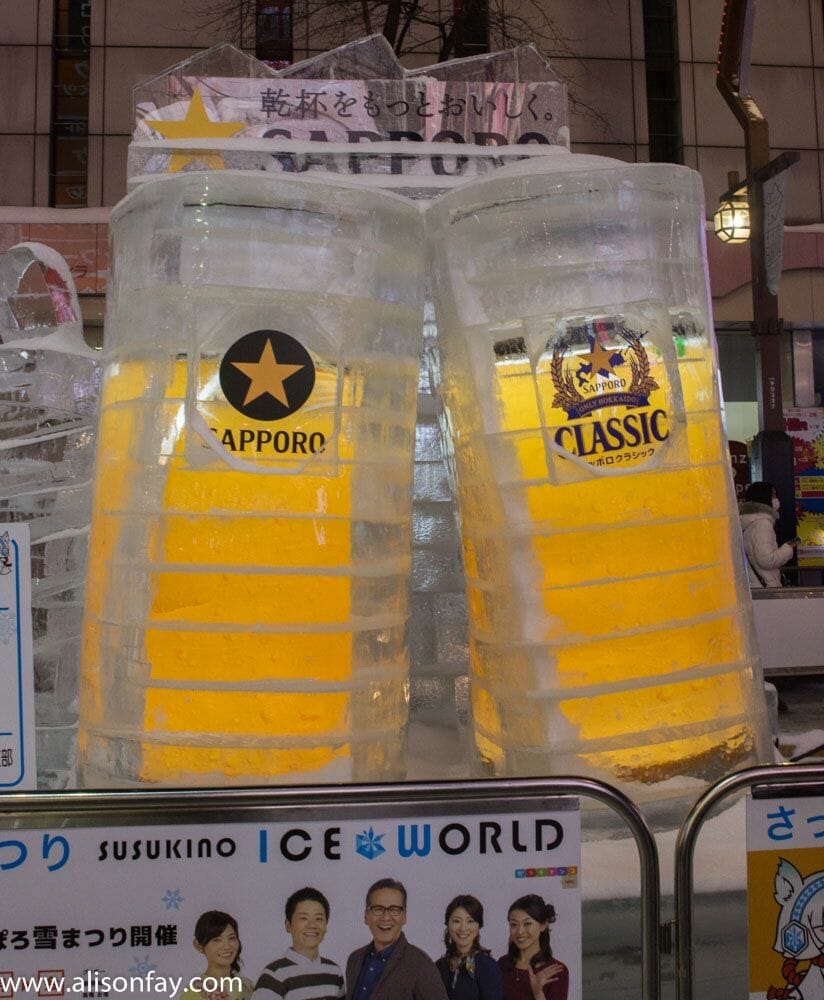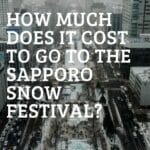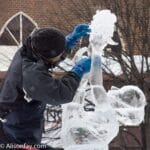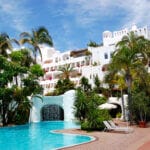During February 2018, I visited Sapporo for the snow festival for 5 days. Japan itself, is not a cheap place to visit and can become quite expensive (especially for accomodation if you opt for hotels over hostels). Which only becomes even more of an issue during the Sapporo Snow Festival. This festival is extremely popular so accomodation sells out quite fast, so you really need to be booking far in advance or be willing to fork out a fortune for accomodation. Being flexible on what style of accomodation you’d be willing to stay in helps a lot, as, some accomodation will increase their prices around this time, especially those on AirBnB.
Although don’t let this put you off, I got lucky. I booked in January, when there was only 1 hostel left and scored a really comfy bed in a cute little hostel for 5 days. I’m not normally someone who stays in a hostel due to my health issues + disability, but it was one of the best places I’ve ever stayed in. In this guide, I’ll cover the costs of accomodation, travel expenses, day trips to Asahikawa snow festival, and food for one person.
If you’re wondering what there is to do at the Sapporo snow festival, how to get around etc check out my Sapporo Snow Festival guide, and if you’d like to also visit Asahikawa’s winter snow festival check out my guide to that here.
Disclosure: This post may contain affiliate links that earn me a small commission, at no additional cost to you.Accomodation for the Sapporo Snow Festival
As already mentioned, accomodation prices do go up during the festival. I recommend booking well in advance (6 months to 1 year in advance). If you are on a budget, then I recommend looking for a hostel or capsule hotel. For a bit of a higher budget then there’s hotels and AirBnbs available. chose to stay in a hostel, in a female-only dorm, in the Igloo Dorm & Breakfast hostel. The cost of this hostel included breakfast, which consisted of toast and eggs. Being a hostel, I had access to a fridge to store food and a kitchen to cook; which helped save a lot on eating out. This made it perfect for me as I was on a really low budget, and although I love having the privacy of my own room, the hostel beds were super comfy, the hostel was really clean and everyone was super friendly.
I recommend booking accomodation within walking distance of the main festival area, to cut down on transport costs or at near one of the stations that go to the main festival area (located at Oodori park). During this time of year, most of the pavements and snow are covered in snow and ice. If you have any issues with walking distances or over snow/ice, I recommend staying as close to the festival as you can. Although you should be aware, that the closer to the festival you are, the more expensive it would be. The Igloo Dorm & Breakfast hostel is about 25 minutes walk from the festival or two stops by train.
If you’re interested in staying in a hotel, you can find some cheaper business hotels such as the APA hotel Sapporo which is quite close to Odori Park. I haven’t stayed here but have had good experiences with APA hotels in other areas of Japan, and I’d definitely stay in their Sapporo one if my budget allowed. Before booking any accomodation, make sure to read my guide on how to find cheap hotels.
Cost of my accomodation: £113 / $144 / 15,600yen.
Eating out during the Sapporo Snow Festival

During the festival, there is a range of street food style stalls available throughout the festival grounds. Most of these will be serving the typical style Japanese street food such as Takoyaki, Okonomiyaki, Yakitori and Taiyaki. I highly recommend trying all of these during your time at the festival. The cost of each dish does vary but you should expect to be paying around 300 to 600 yen (£2.50-£5) for them. You may find some stalls selling Ramune, which is also worth trying and could set you back about 150 yen.
If you’re on a really tight budget, you can always pop to a 7/11 or Family Mart convenience store and get a larger meal for around 500yen that they can heat up for you and drinks for about 70 to 200yen (water being the cheapest, soda being more expensive). There are also tons of restaurants available throughout Sapporo, including a large number under Odori Park itself, in an underground shopping mall called Pole Town. The restaurants located within Pole Town could set you back about 600 to 1000 yen depending on the dish.
If you are staying in a hostel or AirBnb that gives you access to a kitchen, you can pick up some groceries from a 7/11 or Family Mart Convenience store to cook a meal. I made use of the kitchen in my hostel and ate the breakfast supplied by the hostel, which saved me a lot of money.
Cost of my food during the festival: £73 / $92 / 9980yen.
Drinking out in Sapporo
I am not that big a drinker, so this is an area that I was able to save money on quite easily. However, I did enjoy a few of the Hokkaido Special Sapporo Beers, and I love Japanese highballs so I drank a few of those. I normally buy alcohol in a convenience store like 7/11, and prices vary from about 70 to 200yen depending on the drink. If you do want to have a few drinks out, you could combine it with the visit to the Sapporo Beer Museum, which has a free tour available with the chance to drink a few beers at the end. The beers in the beer museum cost 200 to 300 yen (£1.50-£2.20/$2-3) and 600yen (£4.40/$6) for the 3 beer variety option.
The great thing about drinking in Japan is you can find bars offering an unlimited, all you can drink package where you pay to be able to drink as much as you like within a certain time frame. These can be around 1200 to 2000 yen, and last 1 to 2 hours. However, some places such as Otaru Beer, do events throughout the year that have unlimited drinking, for an unlimited time. Otherwise, you can probably expect to pay between 300 to 600 yen for a beer, possibly higher if you are drinking spirits or wine. Drinking can quickly become quite expensive so if you’re on a tight budget, I’d just stick to the 7/11 selection like I did.
Cost of my drinks during the Sapporo festival: £21/$26.45/2871

Travelling around Sapporo during the festival
During my time at the festival, I mainly took the train to the festival, and to other attractions around Sapporo. I took the bus to a few places, such as the other sites at the Sapporo Snow Festival and the beer museum.
Most of the train journeys I took were covered by my JR pass, although there were a few buses and train journeys that were not covered.
Cost of my travel around Sapporo: £23.45/$29.53/3210yen.
Attractions at the snow festival & around Sapporo
There’s a range of attractions to do at the festival, most are free of charge but there are some costs for things like going up the Sapporo TV Tower. If you choose to visit the Asahikawa winter festival, there are some attractions that cost money such as snow rafting. Although both still have a range of free activities like ice skating, and tobogganing so you don’t actually have to spend any money to have a good time. If you choose to do other things in Sapporo you may incur costs, such as going up the Hitsujigaoka observation hill.
I opted to go up the Sapporo TV Tower, which cost me 720 yen. I also paid 500yen for snow rafting at the Asahikawa festival, and I spent 520 yen to go up the Hitsujigaoka observation hill.
Cost of attractions: £12.73/$16/1740yen
Getting to Sapporo
The cost of getting to Sapporo will be based on how you opt to travel there and where you’re originating from. There are four ways of getting to Sapporo – train, bus, car or flying.
If you’re visiting other areas of Japan, and have purchased a train pass such as the JR Pass then you’ll be best off travelling to the festival on the trains. However, if you’re not opting for a travel pass, using the buses can be cheaper although flying is much quicker. If you need help finding cheap flights to Japan, make sure to check out my tips on finding discounted and cheaper flights.
I chose to fly into Tokyo, and a return ticket from Bristol via Amsterdam to Tokyo cost me £460. If I had chosen to fly direct, it was over £800 so by going non-direct I did save quite a big chunk of money. I used my JR Pass to travel from Tokyo to Sapporo, and back.
Cost of flight: £460
Cost of JR pass: £339/$426/46,390 yen
Foreign Currency Exchange + ATM withdrawal fees
If you need to withdraw cash, or exchange cash while in Japan there will most likely be some form of fee involved. Even if your card has no currency exchange fees, the ATM may still charge. 7/11’s ATMs do not normally charge fees for using them so I recommend using those. If you live in Europe or have a passport from a European country, make sure to sign up for Revolut and get one of their debit cards so you can withdraw a few hundred £ from an ATM before you pay any foreign transaction fees. As I use Revolut, I was able to benefit from these free currency withdrawals while in Sapporo.
Cost of currency exchange + ATM withdrawal fees: £0, no costs incurred.
Other misc costs
If you’re like me and suffer badly from the cold, I really recommend packing a scarf or snood, a warm hat and gloves. I didn’t pack anything but gloves, so I had to go shopping when I arrived. I managed to locate a fairly warm hat in Daiso, although it was around £3.50/$5/500yen, and a snood from a store under Odori Park for £18.50/$25/2500yen. While I love the snood, and it was really warm and will be used for future trips, £18.50 is a lot more than I would have paid had I bought one before I left England.
You may also want to buy hand or body warmers, to help keep yourself warm. These are a few hundred yen a pack in 7/11 or Family Mart. They’re super useful and definitely worth buying if you’re susceptible to the cold like me. You may also want to buy some souvenirs to take home, I got myself a fridge magnet which cost me about 500 yen. Plus you could easily incur some other misc costs for things like toiletries, towel hire in a hostel etc. So it’s a good idea to allow a few thousand yen to cover these things.
Misc costs: about £28/$38/3800yen
Total costs of visiting the Sapporo Snow Festival (for 1 person): £731.18 / $917.18 / 99,615.76yen
More Travel Tips & Resources
- Get Travel Insurance – Don’t leave home without travel insurance. Travel insurance can cover you in case you have an accident, get sick, lose your passport or other belongings, miss your flight, andis canceled/delayed. If you’re in the UK, I recommend using Allclear, for the USA you should consider AXA and for the USA, UK & Rest of the World check out SafetyWing.
- Hiring a car – I recommend booking your car hire through Discover Cars. They offer 24/7 support, and free cancellation. They help by finding the cheapest car hire available, by searching hundreds so companies so you don’t have to.
- Booking budget-friendly accommodation – I normally book hotels and hostels through Booking.com, as they allow me to filter for properties based on my needs. They also have a great free cancelation policy. For my UK holidays, I normally use Park Holidays to book lodges/caravans and pet-friendly accommodation. For long-term stays and holiday rentals, I use VRBO.
- Booking Tours – When I am booking tours, I like to use GetYourGuide or Tiqets. They both have great selections of guided tours, skip-the-line tickets and city passes.
- Booking Flights – I always find my cheapest flights using Kiwi or Skyscanner. Both search for the cheapest flights, and let you filter by stops, times, etc so you can find the cheapest options. You can also sign up for Jack’s Flight Club to be alerted to cheap deals if you’re happy to travel anywhere.
- Travel eSims – If your phone supports an eSim, I recommend using Airalo. They sell eSims based on country, region, and even global ones! There’s one for almost every country and they can work out cheaper than sim cards.
- Travel Sim cards – If you don’t want an eSim, then this Orange travel sim card will have you covered for Europe or this Global Sim Card that works in over 200 countries. Make sure to check out my sim card guides for information on buying local sim cards.
- Face masks – Not just for covid! I’ve worn an n99 face mask on planes since 2017, as they’ve helped me avoid getting sick from other passengers’ germs and avoid bad smells. I always wear a Cambridge Mask when visiting countries with high pollution such as Taiwan, as they help against air pollution, bacteria, and more.
- VPN – Whilst traveling you’ll normally end up using WiFi in public places or at your accommodation, which may not be fully secure. I recommend using Proton VPN, as they don’t track your browsing history and are reasonably priced.





